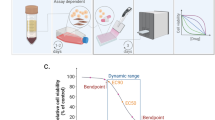Summary
Numerous procedures have been described which test the chemosensitivity of tumor cell lines. A major disadvantage of most of these assays is that practical limitations prevent the testing of more than a few variables. We have adapted a rapid and efficient colorimetric assay for testing the chemosensitivity of human lung tumor cells. In this assay, a tetrazolium salt (3-[4,5-dimethylthiazol-2-yl]-2,5-diphenyl-tetrazolium bromide, MTT) is converted to a colored formazan product by enzymes active only in living cells. The MTT assay may be carried out entirely in 96-well microtiter plates, so that large experiments examining a number of variables can be readily performed. Thus, drug concentration, time of exposure to drug, length of assay, and cell density can be varied and tested. Moreover, the simplicity of this assay allows simultaneous testing of multiple drugs on multiple cell lines. Finally, the MTT assay is useful for monitoring the development of multidrug-resistant cells in culture.
Similar content being viewed by others
References
Alley MC, Uhl CB, Lieber MM (1982) Improved detection of drug cytotoxicity in the soft agar colony formation assay through use of a metabolizable tetrazolium salt. Life Sci 31: 3071
Alley MC, Powis G, Appel PL, Kooistra KL, Lieber MM (1984) Activation and inactivation of cancer chemotherapeutic agents by rat hepatocytes cocultured with human tumor cell lines. Cancer Res 44: 549
Anger B, Bockman R, Andreeff N, Erlandson R, Jhanwar S, Kameya T, Saigo P, Wright W, Beattie EJ, Oettgen HF, Old LJ (1982) Characterization of two newly established human cell lines from patients with large cell anaplastic lung cancer. Cancer 50: 1518
Bech-Hansen NT, Sarangi F, Sutherland DJA, Ling V (1977) Rapid assays for evaluating the drug sensitivity of tumor cells. J Natl Cancer Inst 59: 21
Chambers SH, Bleehen NM, Watson JV (1984) Effect of cell density on intracellular adriamycin concentration and cytotoxicity in exponential and plateau phase EMT6 cells. Br J Cancer 49: 301
Cole SPC, Campling BG, Dexter DF, Holden JJA, Roder JC (1986) Establishment of a human large cell lung tumor line (QU-DB) with metastatic properties in nude mice. Cancer (in press)
Ellison M, Woodhouse D, Hillyard C, Dowsett M, Coombes RC, Gilby ED, Greenberg PB, Neville AM (1975) Immunoreactive calcitonin production by human lung carcinoma cells in culture. Br J Cancer 32: 373
Ferguson PJ, Phillips JR, Selner M, Cass CE (1984) Differential activity of vincristine and vinblastine against cultured cells. Cancer Res 44: 3307
Finlay GJ, Baguley BC (1984) The use of human cancer cell lines as a primary screening system for antineoplastic compounds. Eur J Cancer Clin Oncol 20: 947
Finlay GJ, Baguley BC, Wilson WR (1984) A semiautomated microculture method for investigating growth inhibitory effects of cytotoxic compounds on exponentially growing carcinoma cells. Anal Biochem 139: 272
Klebe RJ (1984) Rapid cloning of mammalian cells with honeycomb cloning plates and nonlethal vital stains. In Vitro 20: 127
Landergran U (1984) Measurement of cell numbers by means of the endogenous enzyme hexosaminidase. Applications to detection of lymphokines and cell surface antigens. J Immunol Methods 67: 379
Ling V (1982) Genetic basis of drug resistance in mammalian cells. In: Drug and hormone resistance in neoplasia. CRC Press, Miami, p 1
Ling V, Thomspon LH (1974) Reduced permeability in CHO cells as a mechanism of resistance to colchicine. J Cell Physiol 83: 103
Matsushima Y, Kanzawa F, Hoshi A, Shimizu E, Nomori H, Sasaki Y, Saijo N (1985) Time-schedule dependency of the inhibiting activity of various anticancer drugs in the clonogenic assay. Cancer Chemother Pharmacol 14: 104
Merry S, Kaye SB, Freshney RI (1984) Cross-resistance to cytotoxic drugs in human glioma cell lines in culture. Br J Cancer 50: 831
Metcalfe SA, Whelan RDH, Masters JRW, Hill BT (1983) In vitro responses of human prostate tumour cell lines to a range of antitumour agents. Int J Cancer 32: 351
Mossman T (1983) Rapid colorimetric assay for cellular growth and survival: application to proliferation and cytotoxicity assays. J Immunol Methods 65: 55
Roobol C, Sips HCM, Theunissen J, Atassi G, Bernheim JL (1984) In vitro assessment of cytotoxic agents in murine cancers: comparison between antiproliferative and antimetabolic assays. JNCI 72: 661
Russell WC, Newman C, Williamson DH (1975) A simple cytochemical technique for demonstration of DNA in cells infected with mycoplasmas and viruses. Nature 253: 461
Salmon SE, Von Hoff DD (1981) In vitro evaluation of anticancer drugs with the human tumor stem cell assay. Semin Oncol 8: 377
Selby P, Buick RN, Tannock I (1983) A critical appraisal of the “human tumor stem-cell assay”. N Engl J Med 308: 129
Shoemaker R, Wolpert-Defilippes M, Kern D, Lieber M, Melnick N, Miller W, Salmon S, Simon R, Venditti J, Von Hoff D (1984) Antitumor drug screening with a human tumor colony forming assay (HTCFA). Proc Am Assoc Cancer Res 25: 1292 (abstract)
Slater TF, Sawyer B, Strauli U (1963) Studies on succinate-tetrazolium reductase systems: III. Points of coupling of four different tetrazolium salts. Biochim Biophys Acta 77: 383
Venditti JM (1983) The National Cancer Institute Antitumor Drug Discovery Program, current and future perspectives: a commentary. Cancer Treat Rep 67: 767
Weisenthal LM, Lippman ME (1985) Clonogenic and non-clonogenic in vitro chemosensitivity assays. Cancer Treat Rep 69: 615
Wilson AP, Ford CHJ, Newman CE, Howell A (1984) A comparison of three assays used for the in vitro chemosensitivity testing of human tumours. Br J Cancer 49: 57
Author information
Authors and Affiliations
Additional information
Supported by grants from the Medical Research Council, the National Cancer Institute, the Ontario Cancer Foundation and the Ontario Respiratory Disease Foundation
Rights and permissions
About this article
Cite this article
Cole, S.P.C. Rapid chemosensitivity testing of human lung tumor cells using the MTT assay. Cancer Chemother. Pharmacol. 17, 259–263 (1986). https://doi.org/10.1007/BF00256695
Received:
Accepted:
Issue Date:
DOI: https://doi.org/10.1007/BF00256695




